
On Friday, 2nd February 2007, there was a full moon. On that day, and also
on the preceding two days, I took some photographs from my front steps.
This page uploaded on Thursday, 8th February 2007
UPDATE: Sunday, 18th February, 2007
CHINESE NEW YEAR
- and the moon is new, so that it's pretty much invisible.
Click
here
to see a website which has quite a lot of information about how Chinese New
Year is observed. Also,
here
is a page which leads to delightful pages about the significance of the
twelve animal symbols in the Chinese zodiac.
UPDATE: Tuesday, 20th February, 2007
I've spent a bit of time hunting on the web for a suitable graphic to put
into this page to show the current
phase
of the moon. I've found one that works OK on my clunky old Windows 95 /
Netscape 4.01 computer. Here it is:
UPDATE, Friday, 13th June 2008
I'm disappointed to note that the "moon-phase" link (above) seems to have
disappeared! I've had a bit of a hunt around on the web to see if it's moved
to a different location, without success. (Other web-pages which include the
link have the same problem as this one, of course.) Its URL - when it used
to work - was http://tycho.usno.navy.mil/cgi-bin/phase.gif .
If you know what's happened to it, and have a kind heart, I wonder if you'd
mind
contacting me
to let me know? In the meantime, the link can still stay, in the
hope that it may "pop up" again at some stage.
UPDATE, Wednesday, 9th July 2008
That US Navy page (and some other good US Navy pages also, apparently!)
have disappeared, without as yet showing any signs of returning. It's a
pity, because there was some really excellent material there. However,
while trying to track down what's happened to them, I've run across this
web-page:
http://www.stardate.org/nightsky/moon/
- which shows the phases of the moon for each day of the current calendar
month, with the option of showing similar data for other months. Simple,
effective, and well worth a look.
(If I find out any more about the missing US Navy material, I'll post the
results here.)
UPDATE, Sunday, 16th November 2008
Well, now - here's a treat! I happened to revisit this page just a few hours
ago, and I was delighted to see that the US Navy's "moon phase" link has
made a comeback - along with other pages that had disappeared previously.
[No doubt you've already noticed that, and are probably wondering what all
the fuss is about - unless it's disappeared again, of course
(hopefully not!).]
The picture above shows the moon from a northern perspective - i.e. pretty
much the way you'd see it if you live in the northern hemisphere. If you
live "down under", as I do, it appears the other way up. So, you have a
choice: you can turn your monitor upside-down (careful!); you can stand on
your head (CAREFUL!!); or you can do the sensible thing and use your
imagination.
If you live in the tropics, of course, things are a bit different again;
probably your best bet in that case is to visualize the picture rotated
through 90 degrees - or you could look at it while lying on your side.
UPDATE: Sunday, 25th February, 2007, at about 11 p.m.
UPDATE: Monday, 26th February, 2007, at about 8 p.m.
UPDATE: Monday, 5th March, 2007, at about 8:30 p.m.
Yesterday (4th March) was the 15th day of Chinese New Year, celebrated in
some parts as the Lantern Festival. (Click
here
to see a very attractive page devoted to one person's hobby of making
Chinese lanterns - as well as other handicrafts, including origami, on other
pages within the site.)
UPDATE: Thursday, 8th March, 2007, at about 7:10 a.m.
Just while I think of it - in my
Humpty Dumpty Book
page, about halfway down, there is a graphic involving the moon which has
something wrong with it. (Some people have unkindly suggested that it
looks more like a banana than a moon, but that's not what I have in mind at
the moment.) Can you see what the problem is...? - and what the implications
are for you if you are of a "tropical temperament": should you visualize the
US Navy's moon picture (above) turned 90 degrees clockwise or
anticlockwise? Does the time of the lunar month - or even the time of
day/night - have any bearing on this?
Another moon-related US Navy web-page is
this one.
There's some quite spectacular material there. Well worth a look!
Another site that provides a moon phase viewer for web pages is
this one.
I can't run it on my old computer (it requires a version of Flash which my
old clunker can't support); but I've seen it on a more modern machine, and
it's impressive. It actually allows you to choose a northern or southern
perspective, which is great! There's also lots of other material there, some
moon related, some not - but all definitely worth a look.
It's quite clear from these various links that the part of the moon we see
from Earth doesn't change. This is due to
tidal effects;
the Earth's gravity has such a strong effect on the moon that, over time, it
has become
locked
into that situation. The moon does rotate; but it takes exactly one
lunar month to so. (This means, of course, that the "dark side" of the moon
is not always the same side! Click
here
to see a graphic which makes this quite clear.)
Another web-page which explains tidal effects very well - from the more
familiar perspective of the moon's effect on the Earth, rather
than the other way around - is
this one.
(The sun's contribution also gets a mention.)
Now - on to the main subject-matter of this page...
I'm old enough to remember very well the first moon landing by
Apollo 11,
on 20th July 1969. I was in my first year at Matriculation College. There
was a room with tiered seating known as the Demonstration ("Dem") Room; a
television was set up in there, and students who had a free line were
welcome to go and follow the action. There was a steady stream of people in
and out of the room; I was fortunate enough to be able to see the big event
and hear Neil Armstrong muff his lines ("One small step for _ man...").
- Or did he? There's some controversy about this. Read the last link given
above, about two-fifths of the way down, where you'll find some discussion
about the matter.
In those days, of course, there was only black-and-white (more correctly,
shades-of-blue-and-grey) television; and the quality of the images coming
back from the moon wasn't all that great anyway. In The Left-Handed
Dictionary, by Leonard Louis Levinson (Collier Books / Collier Macmillan
Publishers, 1963), among several definitions of "television" are Frank Lloyd
Wright's "chewing gum for the eyes" and Bob Hope's "smog with knobs". I
don't think I've ever seen smoggier chewing gum than I did on that day; but
it was exciting nonetheless, and I'll never forget it.
UPDATE, Tuesday 21st July, 2009 - forty years on!
What a treat it's been over these last few days to be reminded of that
wonderful time, as newspaper articles and TV programmes have brought it all
back for us.
Launceston's Sunday Examiner newspaper (19th July) featured (on page 19) an
article headed "New photos show Apollo leftovers". There's a NASA photograph
taken by the Lunar Reconnaissance Orbiter, which was launched only last
month, of the Eagle's descent module, which is still sitting peacefully in
the Sea of Tranquillity all these decades on. You can see the photo by
visiting
this
NASA web-page, or clicking
here.
ABC-TV's "Catalyst" science programme last week (Thursday, 16th July 2009)
ran a Moon Special. At the time of writing, this is available for download
as a vodcast from the ABC's website; click
here.
It tells the story of how the Australian radio telescope at
Parkes
(which was the setting for the 2000 movie
"The Dish")
and the NASA Tracking Stations at
Honeysuckle Creek
and
Tidbinbilla
played a vital part in
bringing that amazing TV coverage to about six hundred million viewers
(about a fifth of the world's population at the time). It's well worth a
look.
(Incidentally, I didn't realize until a few days ago that the story as told
in "The Dish" is not quite factual in certain respects, and that Neil
Armstrong's famous words were in fact relayed not through Parkes but
through Honeysuckle Creek. Visit
this
web-page to read more on this, along with a few related interesting
snippets of information.)
UPDATE, Monday 3rd September, 2012
I'd like to quietly acknowledge the passing of Neil Armstrong, who died on
Saturday 25th July, just over a week ago.
The Wikipedia page about the first person to
walk on the moon
is well worth a read; click
here.
For someone who achieved a great deal in what must have been quite an
exciting (even hair-raising!) life, it's clear that he was an unassuming
gentleman who did not seek glory for himself, and a fine example to others
who would aspire to make a real contribution to history.
- And what a contribution! How do you top that?
Of course, since that time there have been suggestions that the whole Apollo
project was a hoax, and that nobody has ever performed small steps, giant
leaps, or any other kind of ambulatory activity on the moon. I'll admit to
having been vaguely interested in the idea at some stage, but I'm not
convinced.
Here
is a web-page which deals with this particular conspiracy theory, in a
characteristically belligerent way.
While on the subject:
Here and there in this website, I've made reference to a book called "The
Cosmic Conspiracy", by Stan Deyo. (Visit my
economic globalization
page to read more.)
So what can we say about "conspiracy theories?" Are they all - by their very
nature - sheer nonsense? Or is there indeed a case for engaging in a modicum
of paranoia?
By way of addressing this in a deliberately oblique manner, some years ago I
wrote a short poem. The main issue I have is the way that many people who
don't think the concept has any basis in fact adopt a smug, scornful
attitude, and use the very term "conspiracy theories" as a cudgel to beat
those who do. My poem is an attempt to place the matter in perspective:
We don't need conspiracy theories, to help us make sense of our life.
( - and you can interpret that any way you like
Who owns the moon?
When the Apollo astronauts went there, they made a point of placing an
American flag. Was this by way of staking a claim?
Well, as everyone was well aware, at the time there was a phenomenon known
as the
"Cold War".
This had existed since the end of World War 2, when Russia - the world's
first communist country - effectively annexed large parts of eastern Europe,
thus creating what became known as the
"Iron Curtain".
As mentioned in one of my other Astronomy pages, Soviet Russia was the first
country to succeed in putting up a satellite - a thing called "Sputnik"
which carried a radio transmitter which went "beep-beep-beep..." and scared
the living daylights out of the "western" countries.
To add insult to injury, "the Russians" later placed another Sputnik
into orbit, and went on to launch the first human being
(Yuri Gagarin)
into space - a short, sub-orbital flight, but a true space-flight
nevertheless.
Well, that was it! The
"Space Race"
was on. It was a matter of pride for both the US and the USSR to be first
to the moon; and, as history records, and as I've already described above,
the US won that particular race in 1969.
So - does that give the US any kind of ownership rights over any part of the
moon?
If you've visited the Wikipedia "Space Race" page whose link appears above,
you'll have read that, after the Apollo project, the US explicitly
disclaimed the right to ownership of any part of the moon.
During the Apollo project itself, there was a certain religious zeal in
evidence; for example:
"Buzz" Aldrin, the second man on the moon, made a point of taking
Holy Communion while there.
Astronaut James Irwin, who went to the moon as a member of the Apollo 15
crew in 1971, later wrote a book:
"To Rule the Night"
(whose title is a biblical reference to the moon), in which he described
his experiences as a lunar visitor. On his return to Earth, he resigned from
NASA and became a Baptist missionary.
UPDATE, Saturday 16th February, 2008
About a month ago, while visiting an old university friend "down south",
I visited a Hobart bookshop and bought a book entitled "Moon Dust", by
Andrew Smith (Bloomsbury Publishing, 2005-6). The author caught a vision to
interview the surviving moon-walkers before it was too late; after all,
it's nearly 39 years since Apollo 11, and none of us is getting any
younger. He was concerned that if somebody didn't do this, an important
body of first-hand knowledge relating to a very important historical saga
would be lost forever. More power to his elbow!
Mr. Smith's intention was to ask the astronauts about their personal
experiences while on their respective moon journeys, and to see "where
they're at" now. He documents Aldrin's and Irwin's experiences - mentioned
briefly above - but the first moon-walker he interviewed was Edgar
Mitchell, who flew in Apollo 14.
Ed Mitchell's story is most intriguing. He was profoundly affected by his
experience as a deep-space astronaut; and after his return, he founded the
Institute of Noetic Sciences to sponsor research into the nature of
consciousness as it relates to cosmology and causality. To learn more, find
and read Smith's book and/or visit
Edgar Mitchell's own website
(click on "EDM bio" within the home-page).
I'm only about two-fifths of the way through the book so far. When I've
finished reading it, depending on what else I find in it, I may get
inspired to add more comments here. Stay tuned...
UPDATE, Tuesday 21st July, 2009 (continued)
Over the last weeks and months, I've been working on a series of new
web-pages about zero-point energy. I finally uploaded them eleven days ago;
they are accessible from
this
menu page.
The fifth (and last, so far) item on that menu is my
Science, scientific method, and ZPE: some thoughts
page. Having just revisited Ed Mitchell's website (in particular, the
"EDM bio"
page mentioned above), in the light of the way my own thoughts have come
together in recent times I now think I'm beginning to understand what he's
on about!
The impression we may get is that the participants knew they were part of
something very special, probably to some extent because they could clearly
see humanity's home - the Earth - as a small, fragile ball against the
backdrop of the vastness of the universe, and were somewhat humbled by the
experience. The comparitive insignificance of a busy mankind's preoccupation
with such matters as politics and economics must have been quite an
eye-opener.
Well, let's hope so - because now, three or four decades on, it's clear that
we need everybody on Earth to catch that vision, before it's too
late. In case you haven't noticed, this website's main raison d'être
is to help bring that about.
This photo is from
a NASA web-page
.
So: does that all mean that "everything in the garden's lovely", and that we
can live in hope that both the Earth and the moon will have a creative and
mutually beneficial future together?
I wonder.
A regular feature in the Sunday edition of Launceston's newspaper, "The
Examiner", is a column by a journalist who identifies herself as "Helen on
the Coast". In the Sunday Examiner of 10th December, 2006, Helen's article
was entitled "Staying in tune for the moon". In the light of recent news
items about a proposed future for the moon, I found it very interesting and
highly relevant.
I sent an email to Helen shortly thereafter, to enquire as to whether I
could perhaps obtain permission to reproduce the article in a page in my
website. She owns the copyright, and has given me permission (many thanks,
Helen!) - so here it is:
Staying in tune for the moon
Fly me to the moon and let me deplete its resources and muck about with its
climate patterns.
We humans have made such a mess of Earth, we are now looking to escape to,
and colonise, our only moon.
The Earth's powerbrokers are shouting "stop the world I want to get off" and
in order to do this they are establishing a lunar station - complete with
commercial opportunities.
The concept is not inside the realm of science fiction.
It is a plan for 2020 - just 13 years away.
The US - surprise me - has announced it will develop rockets and spacecraft
to get people to the moon and establish a rudimentary base.
There, other countries and commercial interests - perhaps a chain of Lunar
Lard outlets to give the local youngsters crater faces - could expand the
outpost.
I am sure the Earth's elite will find many a nice night to enjoy a
moondance.
But while they swoon, us plebs on their former planet below will continue to
unravel through a series of hurricanes, tsunamis, floods and droughts.
Boy, have we made a mess of things in the 50 years since Neil Armstrong took
that first big step for mankind.
We can't say we didn't see this coming.
We just chose to ignore the signs that all was not right with the world.
We falsely assumed our greed would not come home to roost for about 10
generations.
But it is all happening a bit faster than expected, isn't it?
Oops.
Our new moon dwellers will be wired for sound.
Apparently there is a place near the lunar South Pole which will provide
enough sunlight for power generation.
And it just happens to be near possible deposits of valuable minerals.
Here we go.
Let's take everything we can from another piece of the universe. If things
go a bit haywire we can always conquer another frontier.
So many planets to rape, so little time.
So how will the new moon dwellers get to their astral home?
The US moon boffins told the press that a versatile, general-purpose land
craft which can put down anywhere would be needed.
And what are the Americans going to call it?
A pickup.
They are nothing if not original.
"You can put whatever you want in the back. You can take it to wherever you
want. So you can deliver cargo, crew, do it robotically, do it with humans
on board," a boffin said.
I have one burning question I need answered.
If humans go a bit nutty under a full moon on Earth, just how loony will
they go under a full moon ON the moon.
Scary stuff.
I just spent a few minutes doing a Google search starting with the phrase
"moon exploitation". You'd be amazed how many sites that brought up. Here
are just a few that I ran across (there are probably hundreds more):
http://www.greaterearth.org/laws/moon_try.htm
This legal document details the 1979 "Moon Treaty", which seeks to set
guidelines for the way nations will use the moon. The question that
immediately occurred to me, as I browsed through it, was: "How is anyone
ever going to enforce this?"
http://www.law.berkeley.edu/journals/btlj/articles/vol4/Danilenko/HTML/text.html
More legal stuff. Note that "Outer space [which includes the moon] is not
subject to national appropriation".
Now cop this:
http://www.lunarregistry.com/info/legal.shtml
Are you still there? - or have you just shot off into orbit, while trying to
get your head around that?
I think Helen and I have made our point. This is a huge can of worms, and I
wonder how many ordinary people have ever even considered the issues.
May I urge you to get involved. Do your own web-searches; read widely.
Think about the implications. Does it matter? If so, how does if affect you?
If you don't like it, what can you do?
One more link which you may find pertinent while organizing your thoughts:
http://www.nss.org/settlement/L5news/1982-opposition.htm
So - who do you want to own the moon?
I've only just started to think about this issue myself, and I don't have
any answers. I'm not even sure that I have all the questions.
Thinking back, there was a time when I would have welcomed a return to a
more vigorous interest in space - but that was in a more innocent era, when
I thought that space exploration may actually lead to a future in which
humanity might at last "grow up" and begin to work together in a mature
fashion for the benefit of everybody.
An era, in short, in which the mighty dollar and military madness didn't
reign quite as supreme as they do now. An era in which there was more to
life than greed and power.
But that all seems like an age ago. Now, we appear to be heading for a
future in which space is treated as just another commodity and/or another
platform from which to wage war. (Visit
this web-page
which addresses both China's recent destruction by missile of one its own
weather satellites and the hypocrisy of other nations which have criticized
the action - even though they have also gleefully engaged in such activities
in the past, and may do so again.)
*
*
*
*
*
While on the subject of military build-ups, war, and hypocrisy, I can't
resist mentioning a couple of satirical songs by
Tom Lehrer
from his 1965 album
"That Was The Year That Was"
(and yes, before you ask, I am the proud owner of a copy of this
inspired work!
"MLF Lullaby"
is about the "Multi-Lateral Force" which was proposed in the early 1960's
to act as a deterrent against nuclear war.
"Who's Next?"
addresses the fact that, in the 1960's, several nations did acquire
"nuclear capability".
Although written well over 40 years ago, these songs are still bang on
target, in an age in which "the good guys" (to quote from "MLF Lullaby")
appear to be totally unable to see the hypocrisy inherent in their own
nuclear capabiltity while complaining bitterly about similar ambitions on
the part of "rogue states", which (they claim ) comprise an "axis of evil".
You can click on the two links above to read the lyrics of the songs, as
well as Tom's cheeky introductory remarks. While you're about it, have a
look around that website and read the lyrics to many other Lehrer songs.
(One of my favourites, also from "TWTYTW", is
"Wernher von Braun",
which is highly relevant to this page's main topic.)
UPDATE, Thursday, 1st January 2009 (Happy New Year!):
Having just a couple of weeks ago figured out how to get my old computer to
play YouTube videos and similar, and having just discovered videos of Tom
Lehrer singing his satirical songs, I've decided to update this page
accordingly! Here are some YouTube links to Tom Lehrer songs:
Wernher von Braun
MLF Lullaby
Who's Next?
There are three pages of Tom Lehrer videos there - 60 clips altogether. All
of the songs from TWTYTW are featured there somewhere, along with lots of
others. Get involved with them and have a good laugh (after you've
finished reading this "moon" page, okay?!).
Also, click
here
to read an article/interview about/with Tom Lehrer in 2003, which explains
why we haven't heard any new material from him for decades. It's a sad
commentary on the state of the world in these troubled times.
*
*
*
*
*
Am I being unnecessarily alarmist? I don't think so.
Who can forget the proposed
"Strategic Defence Initiative"
(SDI, also known as "Star Wars") of the 1980's?
The idea was pooh-poohed by the scientific establishment at the time, and
ultimately didn't "get up". But recently there have been rumblings about the
possibility of again considering something similar (see
this link.)
Pardon me, but - what "better" place to operate such a system than from the
moon?
Unfortunately, Tom Lehrer is right to be reticent about the place of humour
in our loony world; and the scenario outlined above is certainly no laughing
matter.
The moon has existed since long before we humans came on the scene. As far
as I'm concerned, nobody has any right to own or control any part of
it - or, for that matter, any other part of "space".
So what do we do?
As I've mentioned, I don't know what the ordinary concerned citizen
can do to keep the moon "in public hands", as it were - but I do believe
that we all need to start thinking very, very seriously about it.
There are some who take the position that there should be no manned space
program at all (see the last Tom Lehrer link above, for example), instead
limiting our impact to the use of robotic systems like the wonderful
Voyager 2
to explore the universe. I don't think I'd go quite that far; I can see a
place in space for such things as medical and engineering research, using
the low gravity of the moon or even the "free-fall" conditions of space
itself as a laboratory - provided that the fruits of such research
benefit the whole of humanity, and don't cost the ordinary citizen a fortune
to access. But
"Buck Rogers"
stuff? No thanks!
But can we trust our leaders and power-brokers to see it that way?
If you've visited my
Why is Mad Teddy mad?
page, you'll have noticed that I began it with the opening words from the
Pink Floyd album
"Dark Side of the Moon".
I'm going to end this page with the closing words from that same album,
which now seem ominously prophetic:
There is no dark side of the moon, really.
~ 3 a.m., 14th March 2007
~ 7 a.m., 17th March 2007
Click on either of these two "waning moon" pictures to see and hear Roger
Waters singing "Brain
"Giant leaps are what you take...?"
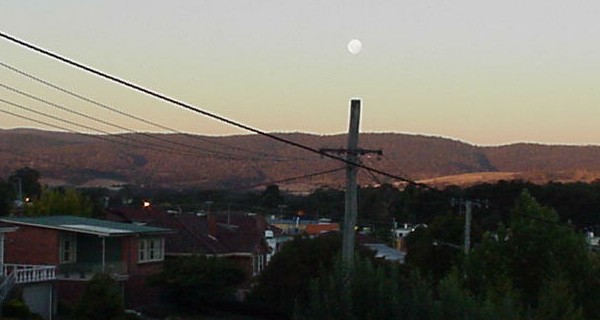
This photo was taken on Wednesday, 31st January. I deliberately took it from
a position which
makes the moon look like a plasma ball being ejected from the hydro pole,
just for a chuckle.
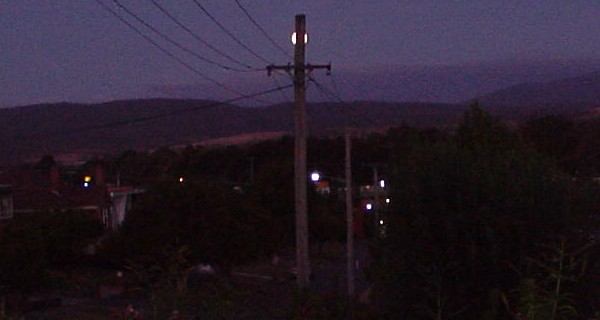
The next evening, 1st February, it was getting dark as the moon rose a
little later (as it is wont to do
from one day to the next). On this occasion, I made a point of positioning
it behind the hydro pole.
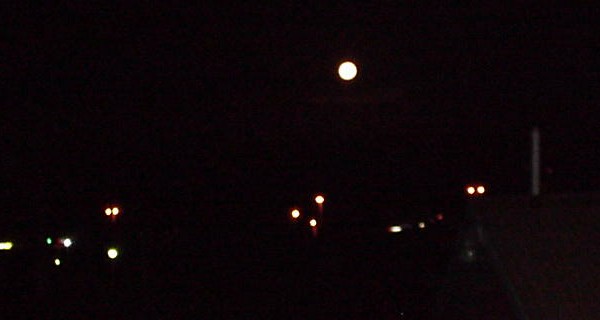
This time, on 2nd February, the moon really was full - and rose into
an almost completely dark sky.
That's about the best I can do with my old Sony Mavica camera! I don't have
the right gear to take really impressive astronomical shots - unlike the
person who took the one below, found on
this Wikipedia page:
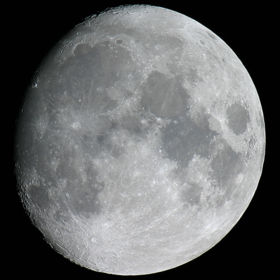
(If you'd like to see some absolutely stunning photos of the moon - many
involving spectacular special effects - click
here.)



 This is a "hot-link" to a picture which is provided on a
US Navy website
and updated every four hours. Generally, it's considered "bad
netiquette" to include hot-links in web-pages; but I've seen this link on
several sites, so I gather that it's OK to do it in this case. (I did try to
send an email to check, but it "bounced" - so in the absence of any advice
to the contrary, the link can stay!
This is a "hot-link" to a picture which is provided on a
US Navy website
and updated every four hours. Generally, it's considered "bad
netiquette" to include hot-links in web-pages; but I've seen this link on
several sites, so I gather that it's OK to do it in this case. (I did try to
send an email to check, but it "bounced" - so in the absence of any advice
to the contrary, the link can stay!  )
)


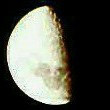 One day after first quarter, I took a few pictures of the moon using a
borrowed pair of binoculars. With my camera held against the right eyepiece
(and with its exposure turned down as far as it would go), and my right eye
(the "good" one) looking through the left eyepiece, I managed to get a
couple of reasonable shots. I then used DISPLAY to perform a gamma
correction down to 25%; this is the result. Not great - but you can get some
idea of how it appears from 41º south!
One day after first quarter, I took a few pictures of the moon using a
borrowed pair of binoculars. With my camera held against the right eyepiece
(and with its exposure turned down as far as it would go), and my right eye
(the "good" one) looking through the left eyepiece, I managed to get a
couple of reasonable shots. I then used DISPLAY to perform a gamma
correction down to 25%; this is the result. Not great - but you can get some
idea of how it appears from 41º south!
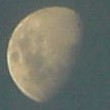 When the moon is at or close to its first quarter phase, it sets at about
midnight (I caught it last night shortly before it set - see above). This
evening, I decided to take some photos while there was still some daylight,
in order to provide less contrast between the subject (the moon) and the
background (the blue sky); hopefully a better picture would result. The best
shot I could get (presented at left) was with the camera's exposure turned
down to minimum (-1.5EV).
When the moon is at or close to its first quarter phase, it sets at about
midnight (I caught it last night shortly before it set - see above). This
evening, I decided to take some photos while there was still some daylight,
in order to provide less contrast between the subject (the moon) and the
background (the blue sky); hopefully a better picture would result. The best
shot I could get (presented at left) was with the camera's exposure turned
down to minimum (-1.5EV).
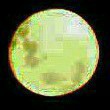 I had intended to take another shot of the moon when it was full (last
night) or a day or two earlier - but either I was busy, or the sky was
cloudy. C'est la vie... but tonight I did get some shots. Again, I used the
lowest exposure, and then did a gamma correction down to 10% to obtain this
picture. The moon, low on the horizon, was a delightful yellow; but after
I'd darkened it to show its features as clearly as possible, it looked more
like a piece of mouldy old green cheese!
I had intended to take another shot of the moon when it was full (last
night) or a day or two earlier - but either I was busy, or the sky was
cloudy. C'est la vie... but tonight I did get some shots. Again, I used the
lowest exposure, and then did a gamma correction down to 10% to obtain this
picture. The moon, low on the horizon, was a delightful yellow; but after
I'd darkened it to show its features as clearly as possible, it looked more
like a piece of mouldy old green cheese! 
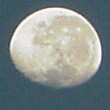
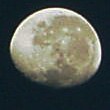 With the moon now into its "waning gibbous" phase, it's still visible as the
sun comes up, and looks really good in a clear blue sky. With the
camera's exposure still set to -1.5EV, I took the shot at left. Then I used
DISPLAY to perform a gamma correction down to 50% (right). The moon's dark
features are quite clearly visible this time. Pretty good, huh?!
With the moon now into its "waning gibbous" phase, it's still visible as the
sun comes up, and looks really good in a clear blue sky. With the
camera's exposure still set to -1.5EV, I took the shot at left. Then I used
DISPLAY to perform a gamma correction down to 50% (right). The moon's dark
features are quite clearly visible this time. Pretty good, huh?!
 You may find
that consideration of my moon pics, above, throws some light on the subject
(pardon the pun.)
You may find
that consideration of my moon pics, above, throws some light on the subject
(pardon the pun.)
 In particular, on that page you can find a very good mpeg movie of the
moon's phases to download. In fact there are two such movies, a small
version and a larger version. (The view is from a northern perspective, so
that the terminator moves from right to left.)
In particular, on that page you can find a very good mpeg movie of the
moon's phases to download. In fact there are two such movies, a small
version and a larger version. (The view is from a northern perspective, so
that the terminator moves from right to left.)

We don't need conspiracy theories, to explain all our trouble and strife.
Who needs machinations with great complications,
to see how they're spoiling our fun?
We don't need conspiracy theories - PLURAL! We only need one.
 ).
).

 There's no doubt that photographs of the Earth taken from space have given
considerable cause for pause to many, many people since, and may well have
helped humanity toward a "greener" perspective on our little planet.
There's no doubt that photographs of the Earth taken from space have given
considerable cause for pause to many, many people since, and may well have
helped humanity toward a "greener" perspective on our little planet.


Indeed.

 ).
).

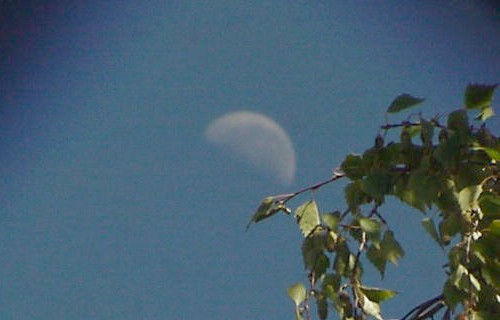
Third quarter, 12th March 2007; taken while leaning against my garage door
at about 10:15 a.m.

As a matter of fact it's
all dark...


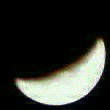 Return to Astronomical stuff menu
Return to Astronomical stuff menu

Damage/Eclipse" at the Live Earth concert in New Jersey, 7-7-2007. Have a
tissue handy...
(Added Thursday, 17-11-2011)

